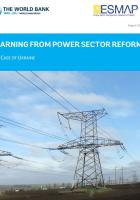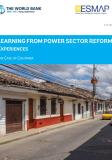Publications
At the time of independence, in 1991, Ukraine had a monolithic state-run power sector. Its main concern was to transform the sector into a more efficient and competitive system that can be consistent with eventual European Union membership. A series of steps were taken in this direction - some unbundling of the sector; limited privatization; establishing a regulator; and creating a wholesale power market. Unfortunately, these reform steps did not achieve the reform objectives, and, at the time, there was no political consensus on the path forward. The changing regional political landscape, especially driven by the Crimea crisis, raised a fresh impetus for the reforms as the sector faced new concerns. Security of supply concerns, particularly over gas from Russia and limited access to high quality coal mines, were suddenly centerstage for a country where the inherited system had excess supply even at peak demand. Sector reforms were undertaken to align more closely with the second and third European Union energy packages. This case study follows Ukraine power sector’s reform process and presents lessons learned that can be useful for other developing countries.



